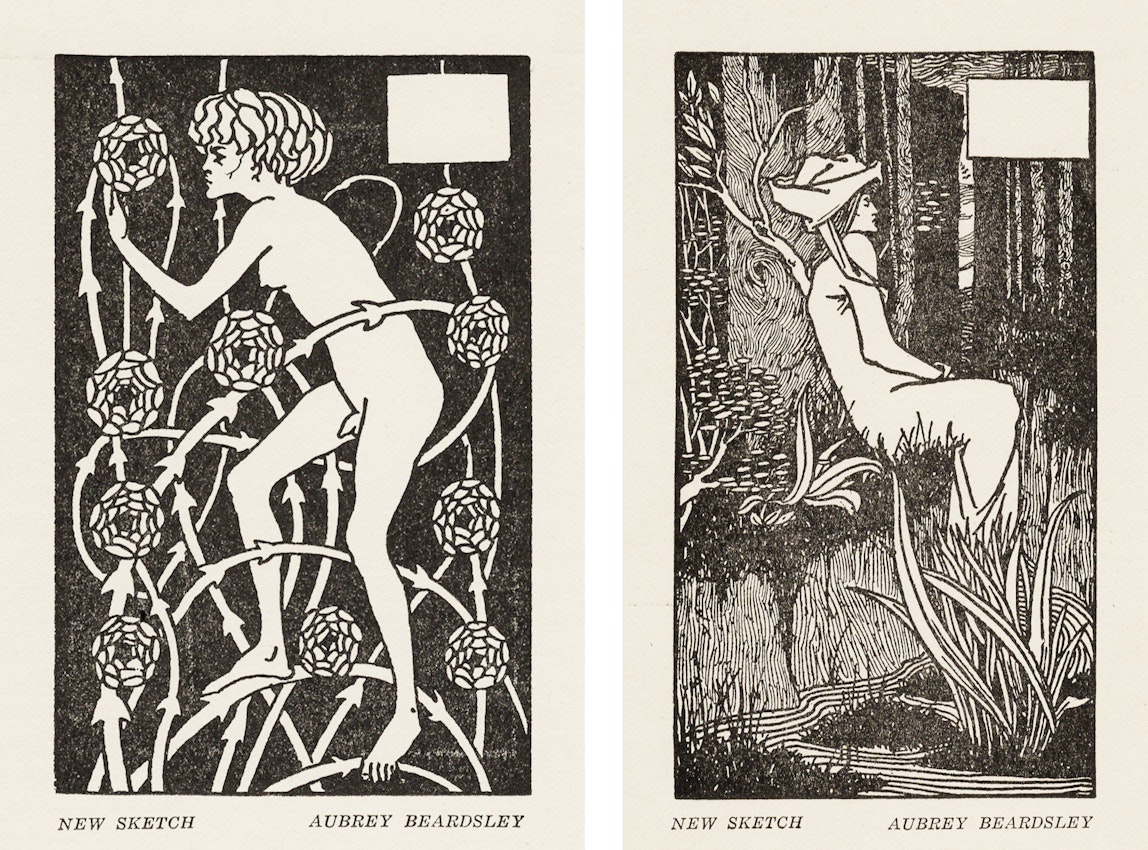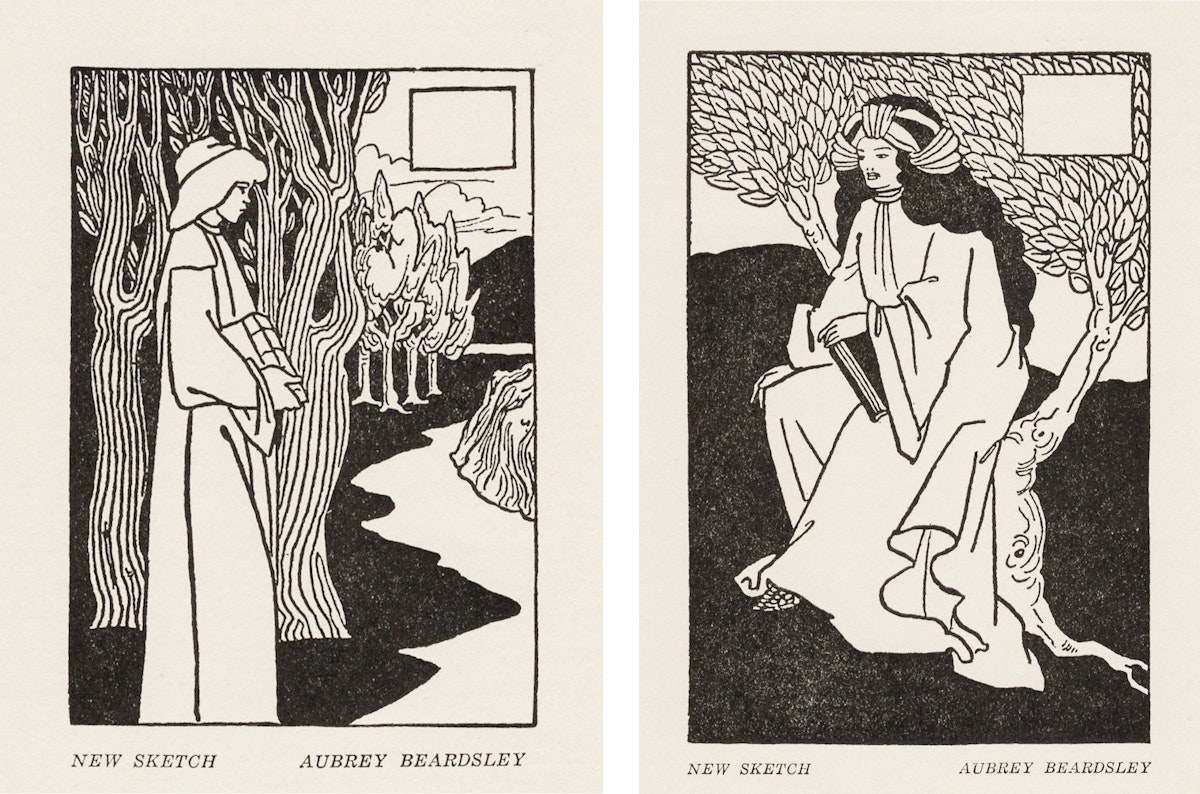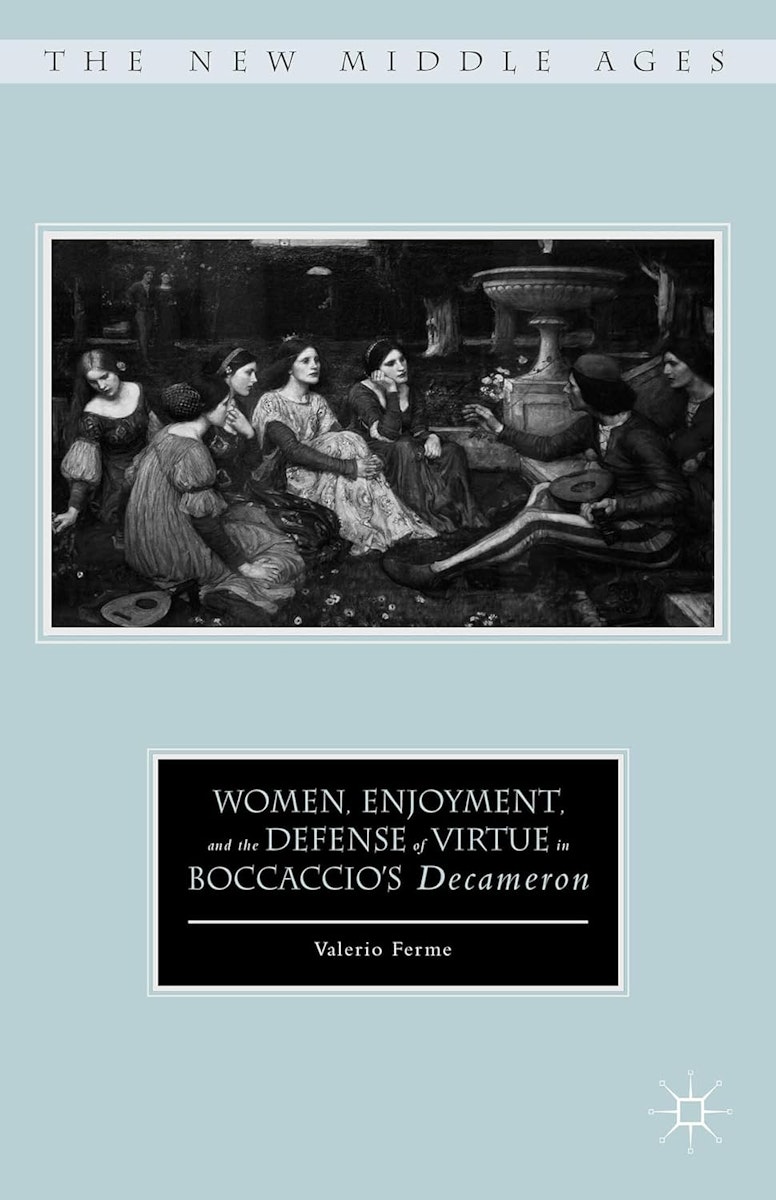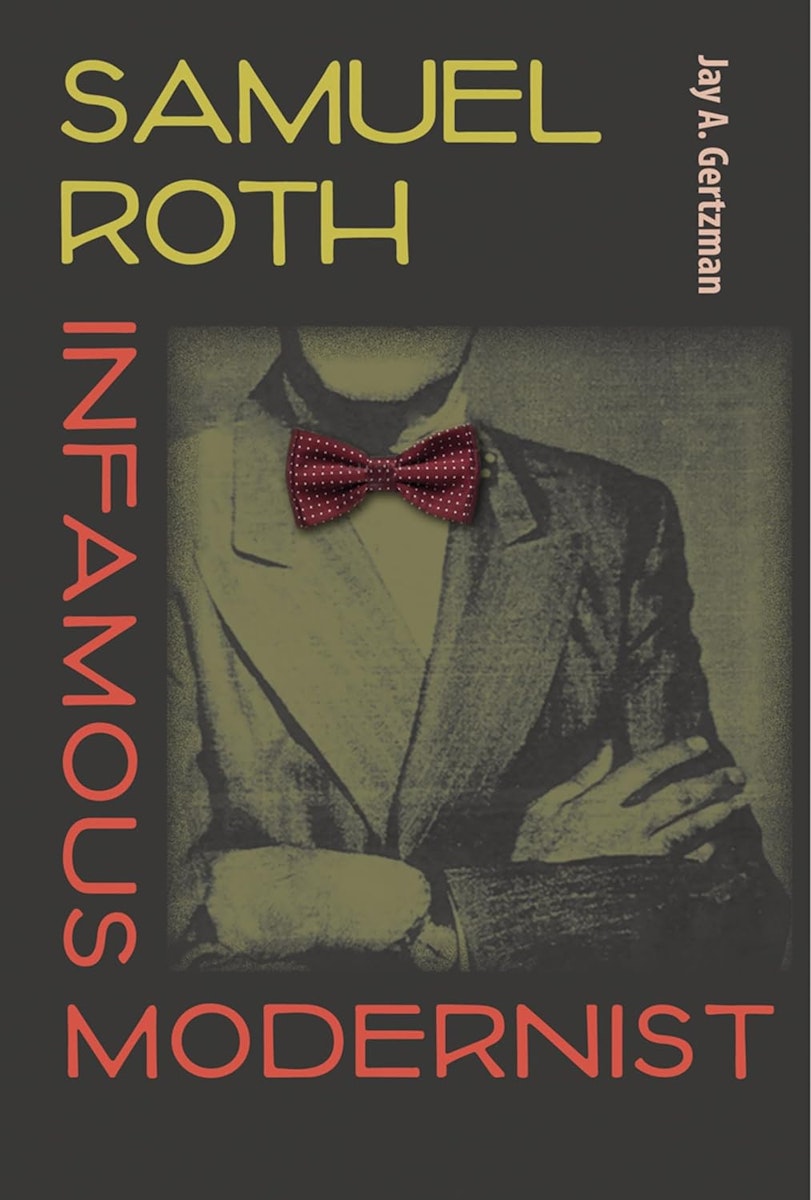
Pseudo-Boccaccio, Yiddish Pulp Fiction, and the Man Who Ripped Off Joyce
In 1927, a pair of lurid “translations” appeared in English, marketed as authentic tales by Giovanni Boccaccio and illustrated with supposedly new works by Aubrey Beardsley. Jonah Lubin and Maria Laurids Lazzarotti search for the origin of these fakes, in which illicit sex begets terrible violence, and uncover a story involving pseudotranslation, Yiddish shund literature, and the piracy king of literary modernism, Samuel Roth.
April 17, 2024
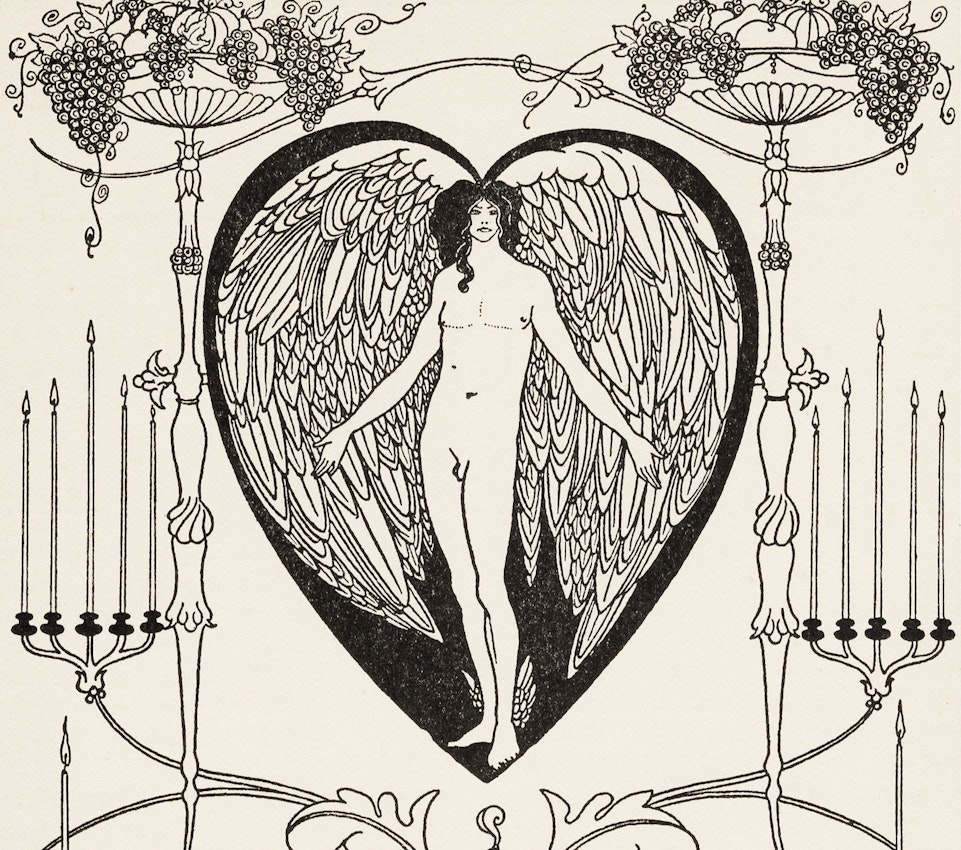 Scroll through the whole page to download all images before printing.
Scroll through the whole page to download all images before printing.“New Sketch” (detail) by Aubrey Beardsley, previously published as “Mirror of Love”, from Pasquerella and Madonna Babetta (1927) — Source.
Deep within the bibliography to the sixth volume of the journal Studi sul Boccaccio (Boccaccio Studies), we find this entry:
[G. Boccaccio], Pasquerella and Madonna Babetta. Two hitherto untranslated stories by Giovanni Boccaccio with some unpublished sketches by Aubrey Beardsley. New York, Biblion Soc., 1927; for private circulation.1
And beneath it, in smaller type, a peculiar note: “Sono operette inventate.” That is to say: these are invented little works, daring forgeries produced by some unscrupulous agent many years after Boccaccio’s death. Who was this agent? No translator is mentioned, but the stories were published by the Biblion Society. Though its name is shared with the Erotika Biblion Society of London, publisher of the pornographic novel Teleny (often attributed to Oscar Wilde), the Biblion Society that printed these stories was an American venture, based in New York. And it was run by none other than that archduke of literary piracy and pornography, Samuel Roth.
Roth inscribed himself fatally into the history of literary modernism as the first person to publish James Joyce’s Ulysses in the United States. While The Little Review had previously published excerpts from the novel, many issues of this journal were seized and destroyed — and its editors charged with distributing obscenity by the New York Society for the Suppression of Vice — creating an opportunity for Roth. He was able to plan an unauthorized, bowdlerized, and error-ridden edition of Ulysses to appear in 1928–29.2 Joyce tried to fight the forthcoming publication with the help of an American law firm, seeking an injunction in the autumn of 1927. In a typically audacious response, Roth appealed to his readers to subscribe to a fund for his defense in the name of “the liberty of beauty”.3
Roth’s editorial license was not limited to radical modernist contemporaries — it extended even to the most canonized figures in the western tradition. In our case, Giovanni Boccaccio. Printed as a “literary supplement” to later issues of Two Worlds, “Pasquerella” and “Madonna Babetta” are titillating tales in which illicit sex begets terrible violence, accompanied with illustrations (supposedly) by Aubrey Beardsley. In “Pasquerella”, the doomed eponymous heroine marries Count Sandro Bernini when she is fifteen years old, and is quickly “made aware of the demands of her marriage”. She gets pregnant; Sandro grows indifferent. Thirteen years later, her son Phillip becomes obsessed with Bianca, the neighbor’s daughter, whom Pasquerella has hired as live-in help. Bianca pleads to her employer, explaining that Phillip has a key to her room and breaks in at night. Pasquerella doesn’t believe the young girl, and decides to sleep in the room herself. In the dark, Phillip mistakes his mother for his would-be lover. “Never before had the core of passion trembled in Pasquerella of its own accord. Under the delicate considerately tenuous fingers of her son it shot into sudden flower.” Disgusted the next morning, she sends him away, under the pretense of education, and gives birth to a child eight months after, whom she abandons to an abbey. Many years later, Phillip returns as a war hero with a new wife, Pamela, and Pasquerella is overcome with “strange, rapidly intensifying emotions”. She recognizes the young woman: it is her child — Phillip has married his sister and daughter. Like an Italian Oedipa, Pasquerella sneaks into their room while they are sleeping, returning to the primal scene — “strange forces were working within her, directing her daggered hand, forcing it . . .” — and ends the chain of incest once and for all.
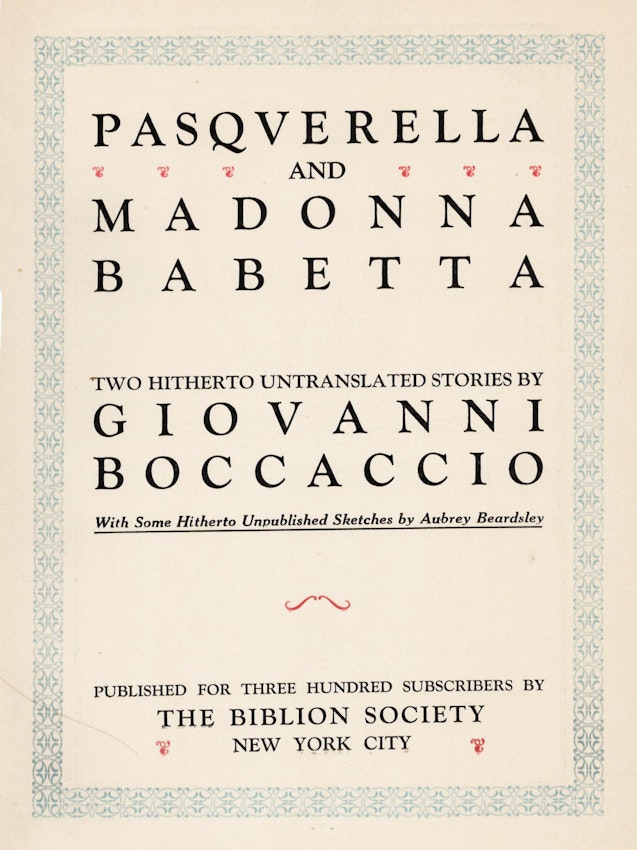 Scroll through the whole page to download all images before printing.
Scroll through the whole page to download all images before printing.Title page from Pasquerella and Madonna Babetta (1927) — Source.
In “Madonna Babetta”, a Neapolitan priest named Lorenzo befriends his Protestant neighbor, Cornelius, “a young man of remarkable physical attractiveness”. They take long walks, discuss religion: “Ah, I see, sighed Cornelius, We burn in hell for the sin of having intercourse with pretty women.” An aristocrat named Madonna Babetta captures Father Lorenzo’s ear and twists the sacrament of confession to her own sordid purposes, claiming that Cornelius has been ogling her in the evenings. Upon hearing these rumors from Lorenzo, Cornelius decides to do exactly the thing he is charged with, hiding in Madonna Babetta’s garden, “hoping to catch a glimpse of his evil double”. When he locks eyes with his accuser, she smiles at him knowingly, and Cornelius recognizes the ruse for what it is. They become lovers. One day, Madonna Babetta murders her husband Helvetius with a dagger, and asks that Cornelius bind her to the bed, arranging the room “as if a desperate struggle had taken place”. When Cornelius later expresses guilt for complicity in her scheme, Madonna Babetta embraces him, dagger in hand, and he slumps over, dead. Taking up the pipe and magnifying glass, Father Lorenzo enters the widow’s garden himself in order to ascertain how two respected men have returned to God before their time. He deduces Madonna Babetta’s role and storms into her bedchamber, demanding a confession for double homicide. “Father, she breathed. Would you not murder to have me now?” We cut to the future:
The sainted Father Lorenzo is seen often mounting the street to the Via Nilla at that hour between four and six when the sea about Naples seems to swoon at the approach of the fiery sun, but it is doubtful whether he is preoccupied with the state of Madonna Babetta’s soul, or that the Madonna has so many sins to confess, for the maid servant has never yet heard, that chant beginning. . . . In Nomine Patri . . . issuing from her mistress’ chamber.
The setting of Pasquerella and Madonna Babetta is a pastiche of premodern Italy à la Boccaccio: full of villas, confessors, and passionate, murderous women.4 The stories are rather entertaining, but there are irregularities of style and detail that would not be found in the authentic works of Boccaccio.5 Though there are many transgressive women in Boccaccio’s work, their depiction is in stark contrast to the lurid, extended violence of Pasquerella and Madonna Babetta. There are also issues of a historical nature. Touched as we may be by the friendship between Catholic and Protestant, it is important to remember that Martin Luther was born more than a century after Boccaccio’s death. Or take for example the colorful mishmash of names, whose morphological disunity is characteristic of archaizing, foreignizing works: the Italian Lorenzo and his good friend, the Latin Cornelius; Madonna Babetta and her husband, Helvetius.6
But Roth was not just content to expand the canon of Boccaccio — he wanted to do Aubrey Beardsley the same favor. The “hitherto unpublished” Boccaccio stories discovered by the Biblion Society were to be illustrated “With Some Hitherto Unpublished Sketches by Aubrey Beardsley”. In fact, all of the illustrations by Beardsley had already been printed. The first, depicting a naked angel, which Roth titled “New Sketch”, had already been published in 1898 under the name “Mirror of Love”. The next four full-page illustrations, all featuring people looking pensive and forlorn amid vegetation, come from the Dent edition of Malory’s Le Morte d’Arthur (1892) — the blank and white boxes in their top right corners were supposed to contain chapter numbers. The final full-page illustration is “Lysistrata Haranguing the Athenian Women”, from an edition of Aristophanes printed privately in 1896.7
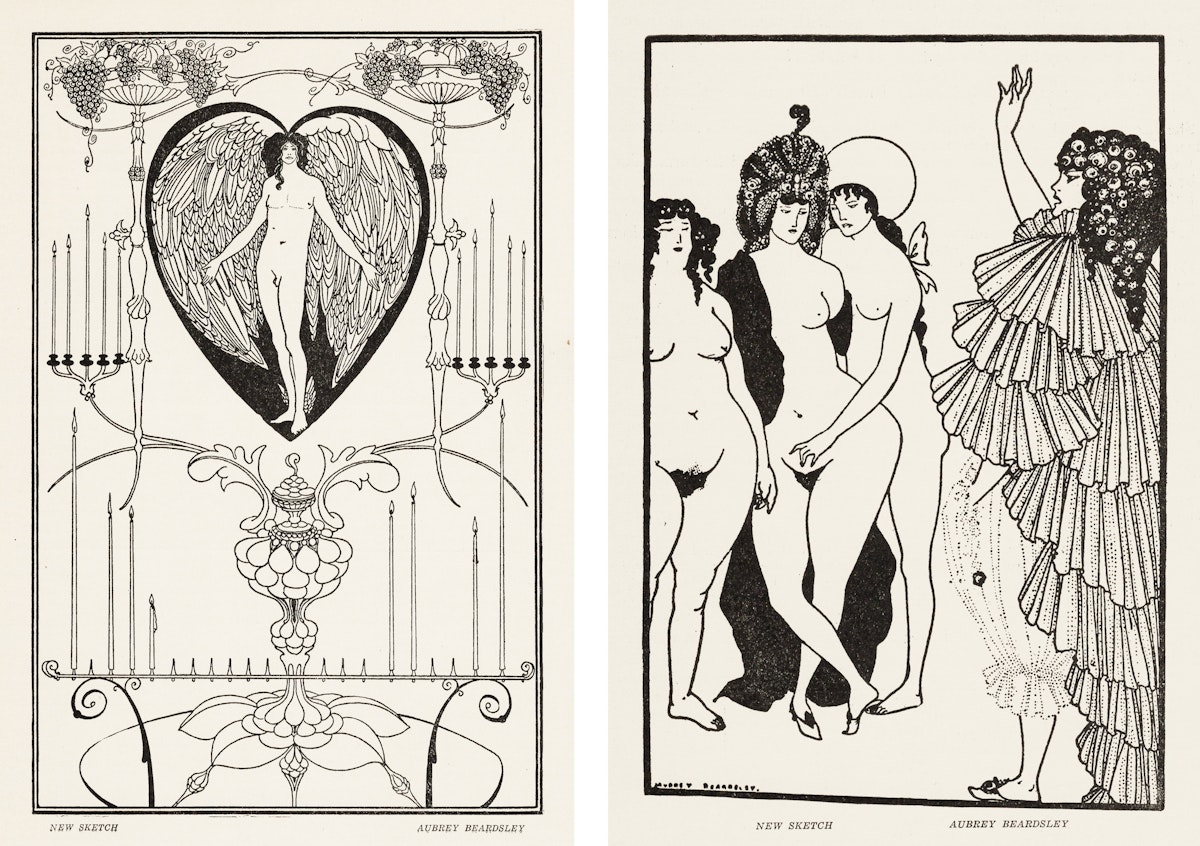 Scroll through the whole page to download all images before printing.
Scroll through the whole page to download all images before printing.Illustrations by Aubrey Beardsley titled “New Sketch” in Pasquerella and Madonna Babetta (1927). The illustration on the left was previously published under the title “Mirror of Love” and intended to illustrate an edition of Marc André Raffalovich’s poetry, while the image on the right, originally titled “Lysistrata Haranguing the Athenian Women”, comes from an edition of Aristophanes printed privately in 1896 — Source: left, right.
There are also sketches that are falsely credited to Beardsley, including the repeated, semi-typographic motifs printed between paragraphs — two women in repose in “Pasquerella”, a young man wooing a woman lying on a phallic sofa in “Madonna Babetta” — and a full-page print entitled “The Governesses Disporting themselves in the Garden”. Finding the origin of these illustrations provides a helpful context for the Boccaccio stories published by Roth. All three of these drawings are in fact by the Hungarian illustrator Willy Pogany, and were published as illustrations to a 1926 edition of The Songs of Bilitis. Released in 1894 under the title Les Chansons de Bilitis, these erotic poems were originally publicized as supposed translations from the Greek poet Bilitis, a contemporary of Sappho. In reality, they were written by the Belgian-born poet Pierre Louÿs who, in the 1926 edition from which Roth must have taken the illustrations, presents himself as the author, not the translator. Les Chansons de Bilitis are thus pseudotranslations: works of literature that claim to be translations from another language but are in fact original compositions by their would-be translator. Intentional or not, lifting illustrations from Bilitis associates Roth’s stories with contemporary European pseudotranslations.
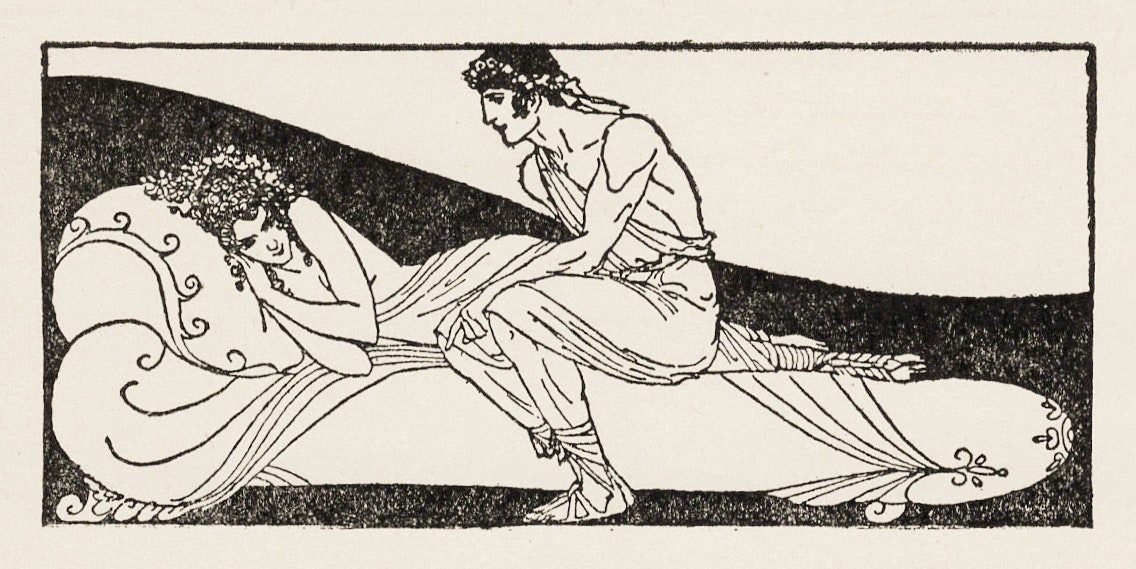 Scroll through the whole page to download all images before printing.
Scroll through the whole page to download all images before printing.Illustration by Willy Pogany for Pierre Louÿs’ pseudotranslation of Bilitis, credited as a work by Aubrey Beardsley in Pasquerella and Madonna Babetta (1927) — Source.
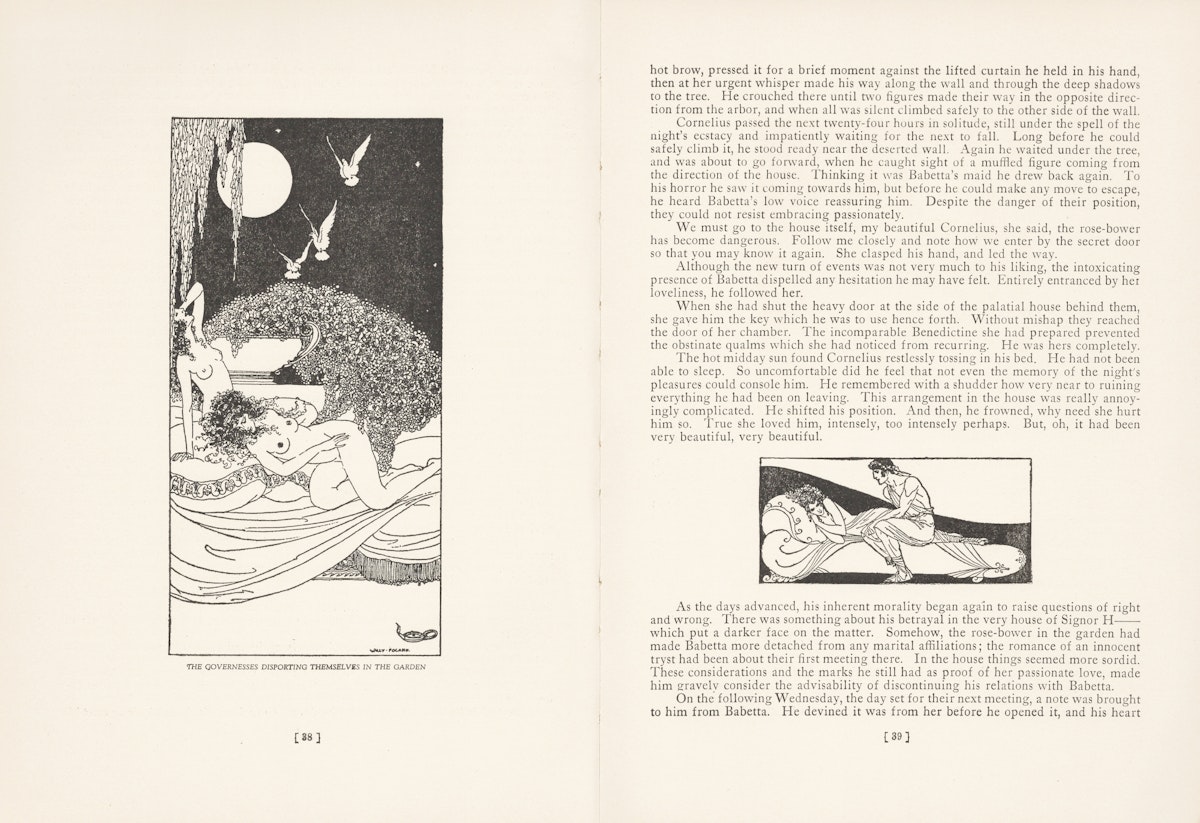 Scroll through the whole page to download all images before printing.
Scroll through the whole page to download all images before printing.Spread from Pasquerella and Madonna Babetta (1927) containing illustrations by Willy Pogany for a 1926 edition of Pierre Louÿs’ pseudotranslation of Bilitis, credited as a works by Aubrey Beardsley — Source.
One wonders why Roth would select images from a pseudotranslation for this volume. Was the decision, in fact, a sort of wink toward the camera, a playful admission of guilt for the inquiring contemporary reader, or, beyond the grave, toward the future collator of his work? Or was the inclusion of these images purely pragmatic: he saw they were effective for marketing one forgery, so why not for his own? Roth produces a space of unanswerable questions as his legacy.
At first glance, it can be tempting to group “Pasquerella” and “Madonna Babetta” with Pogany’s Bilitis or James Macpherson’s Poems of Ossian, relatively poor forgeries which purported an ancient source. A simple explanation for their provenance would be that “Pasquerella” and “Madonna Babetta” were fabricated by Roth or by someone in his employ. And if this were true, the case would likely be closed . . . but two pamphlets, written in Yiddish and published at the turn of the century by the Hebrew Publishing Company, make this story all the more strange.
***
Even if you are a student of Yiddish literature, there is a good chance you have never heard the name Dovid-Moyshe Hermalin. He, like Roth, was an immigrant to America. He came from Romania in 1885, when he was twenty years old, and died when Roth was seventeen. One is tempted to imagine a meeting between the two, perhaps in a cafeteria on the Lower East Side, where you could get stewed fruit: the Yiddish writer in the last year of his life and the young correspondent for the New York Globe. But, with no record of its occurrence, to describe such a meeting is pure fabulation. Though Hermalin was among the most prolific and popular Yiddish men of letters in his day, he has been all but forgotten. This is likely because his writings would be classified post facto as shund, and thus excluded from the Yiddish canon. Literally, shund derives from a German term referring to the unusable remnants of an animal left over after slaughter and processing, but in Yiddish it means, more or less, “trash literature”, or perhaps more generously “pulp fiction”.8 Shund literature usually appeared in newspapers, and the stories were often titillating, full of sex and suspense, and written to sell. Around the turn of the century, vocal Yiddish intellectuals began to rail against shund, decrying it a poor representative of Jewish culture and deleterious for the impressionable Yiddish-reading public.
This was a common critique: shund literature was too indebted to European models, too bound up in translation, to be properly Jewish. It did not conform to a politics of Jewish national autonomy. According to the leading Yiddish intellectuals at the time, Jewish literature, like the Jewish people, needed be one among many, on the same plane as the peoples and literatures of Europe, not dependent on or subservient to them. The Yiddish authors who have been canonized, and therefore disproportionately translated, are those whose work conformed, mainly, to a non-shund model. Recent projects have tried to turn the tide of research away from canonical Yiddish literature and toward shund, acknowledging its central position in the reading lives of Yiddish speakers and recovering its visibility.9
Hermalin wrote shund novels alongside works of popular philosophy and journalism, but it seems his real specialty was the translation or adaptation of popular European authors for the Yiddish-reading public. In our database of translations into Yiddish, we have so far identified twenty-four such works. He wrote “adaptations” of Goethe, Conan Doyle, Swift, Maupassant, Zola, Shakespeare, Tolstoy, and, as you might have guessed, Boccaccio. He generally worked with the Hebrew Publishing Company of New York, one of the most prolific producers of Yiddish reading material during those boom times, when various Czars’ censors, all but banning the Yiddish publishing within Russia, inadvertently turned New York into the printing press for the Yiddish world.
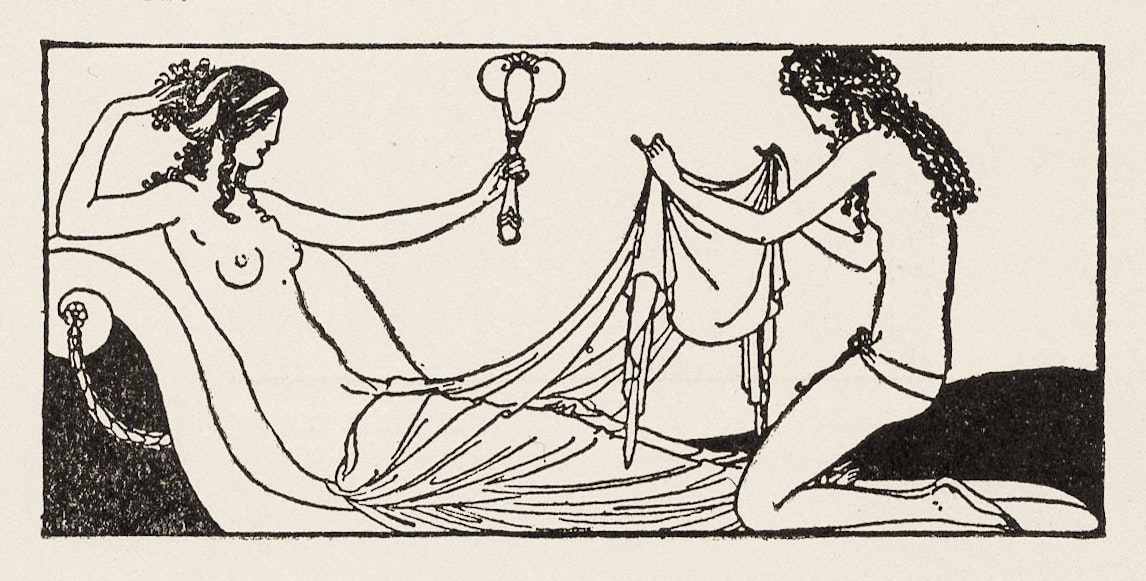 Scroll through the whole page to download all images before printing.
Scroll through the whole page to download all images before printing.Illustration by Willy Pogany for Pierre Louÿs’ pseudotranslation of Bilitis, credited as a work by Aubrey Beardsley in Pasquerella and Madonna Babetta (1927) — Source.
Around the turn of the century, Hermalin produced two adaptations of Boccaccio: Paskarela with the press of B. Rabinovits, and Madam Babeta with the Hebrew Publishing Company. In contrast to Roth’s “hitherto untranslated”, it is stated on the cover page of both stories that Hermalin had “baarbet” (adapted) these works from Boccaccio. This gives him a little wiggle room, though the introduction to Madam Babeta does explicitly state that it is “one of the best stories from the Decameron”.
Paskarela and Madam Babeta are longer versions of those same stories that Roth printed in English twenty-seven years later. Unless some proto-version of these two stories surfaces, the most likely explanation seems to be that the tales were composed by Hermalin as pseudotranslations of Boccaccio, and that Roth (or someone close to him) translated these stories and passed them off once more as authentic, lost stories by Boccaccio. By birth a Galician Jew, Roth knew Yiddish, and used Yiddish sources to produce translations of Heinrich Heine, since he had no German.10 He was also an inveterate publisher of phony translations, with sensational titles such as 1941’s I Was Hitler’s Doctor and 1951’s My Sister and I, supposedly a lost work by Nietzsche. He had the means, the motivation, and the sheer brazenness necessary to take a pair of Yiddish fakes, translate them into English, and pass them off as genuine discoveries to an unsuspecting literary public.11
Roth was situated in a strange middle place. The free way he dealt with authorship has much in common with the prior generation of Jewish-American literary production. He would have done well with the Hebrew Publishing Company, where, for example, Thomas Mayne Reid was falsely presented as Jules Verne, and German adventure novels were published as the work of Jewish authors.12
Of course, if Roth were to market Hermalin’s pseudo-Boccaccio to his literary, anglophone market, the stories would have to be adapted. The English versions are significantly shorter than the Yiddish (in the case of “Pasquerella”, seventeen vs. eighty-three pages), and the style of the English is significantly more reserved. The Yiddish narrator delights in parables — he philosophizes on the incontinence of human nature, on inexorable desire, and he often addresses the reader directly. At one point, he asks us: “Have you ever plucked a rose from a bush? Yes?” and then uses the rest of the paragraph to compare Pasquerella to that rose. Roth’s version, conversely, sticks to indirect, third-person narration, and pretends toward a sort of Anglo-Saxon dignity. For example, that same rose simile is retained in the English, but it is framed instead as “Whoever has plucked a rose from its branch . . .” The Yiddish version is also significantly more explicit in its descriptions. Hermalin describes the large bosoms, plump arms, and broad shoulders of Pasquerella and Babetta with relish, over and over, and the blood of their murdered victims is bright red and comes forth in lurid sprays. Roth, publishing for a public with literary pretensions, seemed to think it wise to tone down the extravagance.13
Had Roth wanted, he certainly could have found other famous works of questionable provenance in the Yiddish press. Hermalin produced two more Boccaccio “adaptations” entitled Printsesin Tsuleyka (Princess Zuleika) and Di Tsvey Poorlakh (The Two Couples). Printsesin Tsuleyka is actually a significantly expanded adaptation of a real story from the Decameron: the seventh story of the second day, about the Sultan of Babylon who sent his daughter Alatiel to the King of Algarve as a wife. But under Hermalin’s hand, Alatiel’s name changes to Zuleika, which also happens to be the traditional name for Potiphar’s wife, the Egyptian woman who tried to seduce Joseph. This biblical story is referenced in both versions of Babetta, and seems to have exerted a special force on Hermalin. And how could it not have? Being, as it is, one of the shund-ier parts of the Hebrew bible.14
***
“Madonna Babetta” and “Pasquerella”, in Yiddish and in English, are but two of countless examples of unlicensed literary appropriations. And although they are, in a sense, rather poor forgeries, they reveal the curious and irreverent ways in which literature is reproduced and kept alive across the boundaries of class and nation by means of adaptation. Boccaccio was an adapter himself: he took material for the Decameron from the whole wealth of narratives that were available to him — from French, Italian, and Latin sources — which in turn adapted stories of non-European origin, probably composed in Arabic and Sanskrit.15 Boccaccio reworked them as he saw fit, and wove them together to create his opus. The Decameron itself was an anthology of adaptations, held together by a well-wrought frame narrative.
A history of translation is incomplete without a proper charting of the muddied streams of unlicensed adaptation, false attribution, and pseudotranslation. Born beside on tributary of the Dniester and buried near the Hudson, Roth, like Hermalin, called this contentious space home. As did Boccaccio, some six-hundred years prior. But while the Decameron has been thoroughly canonized, the texts that Roth, Hermalin, and their comrades produced by these practices have been forgotten, relegated to the dustbin of literary studies as shund, marginalized as curiosities. A shame, because texts of this sort constituted an outsized proportion of the material that readers actually read. Texts like these, and not the canonized classics, were the bread and butter of the popular press. To understand the functions and methods of translation as they were and are — not as they are supposed to be — we must turn attention to these stories.
Boccaccio, Hermalin, and Roth all belong to the same tradition. They are collators, adaptors, collectors, and tellers of tales. And if we are to study them, then we must be too. All the more so because Hermalin and Roth did not provide frame narratives for their stories: they published no acknowledgements with their texts; none of that sinew which connects the femur to the hip. Perhaps out of piety, that fleshy byproduct, the origin of shund, was thrown away. So it is up to us to produce the frame story for Hermalin and Roth — to bring bones together, put tendons and flesh upon them. This is done by problematizing these fraught and fascinating moments of transmission: fleshing out the story. Or, otherwise, by fishing around in the trash.
Jonah Lubin is a writer, translator, and student of literature, interested in Yiddish, translation studies, and Digital Humanities. He is building a database of translations into Yiddish.
Maria Laurids Lazzarotti is an Italian writer studying comparative literature in Berlin. They write about queer pockets of time.





